The iPhone 5s Review
by Anand Lal Shimpi on September 17, 2013 9:01 PM EST- Posted in
- Smartphones
- Apple
- Mobile
- iPhone
- iPhone 5S
Display
The iPhone 5s, like the iPhone 5c, retains the same 4-inch Retina Display that was first introduced with the iPhone 5. The 4-inch 16:9 LCD display features a 1136 x 640 resolution, putting it at the low end for most flagship smartphones these days. It was clear from the get-go that a larger display wouldn’t be in the cards for the iPhone 5s. Apple has stuck to its two generation design cadence since the iPhone 3G/3GS days and it had no indication of breaking that trend now, especially with concerns of the mobile upgrade cycle slowing. Recouping investment costs on platform and industrial design are a very important part of making the business work.

Apple is quick to point out that iOS 7 does attempt to make better use of display real estate, but I can’t shake the feeling of being too cramped on the 5s. I’m not advocating that Apple go the route of some of the insanely large displays, but after using the Moto X for the past month I believe there’s a good optimization point somewhere around 4.6 - 4.7”. I firmly believe that Apple will embrace a larger display and branch the iPhone once more, but that time is just not now.
The 5s’ display remains excellent and well calibrated from the factory. In an unusual turn of events, my iPhone 5c sample came with an even better calibrated display than my 5s sample. It's a tradeoff - the 5c panel I had could go way brighter than the 5s panel, but its black levels were also higher. The contrast ratio ended up being very similar between the devices as a result. I've covered the panel lottery in relation to the MacBook Air, but it's good to remember that the same sort of multi-source components exist in mobile as well.
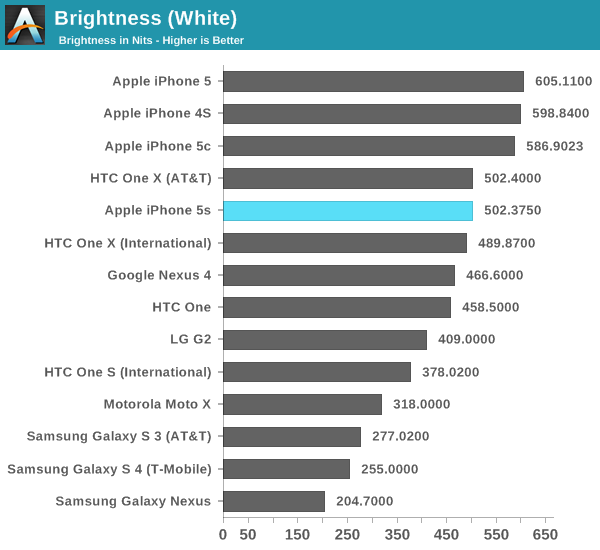
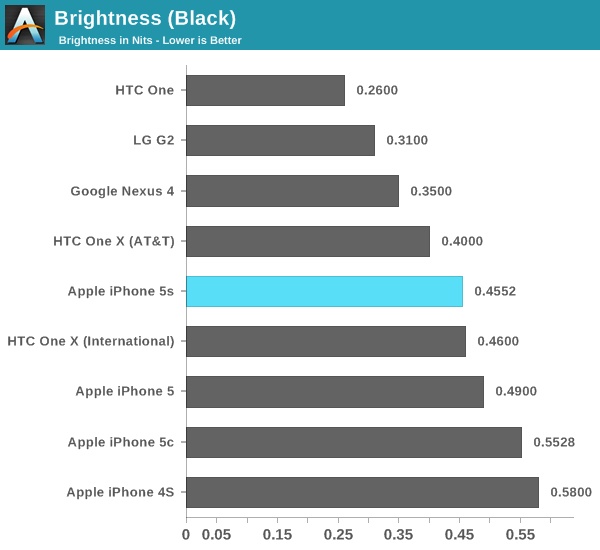
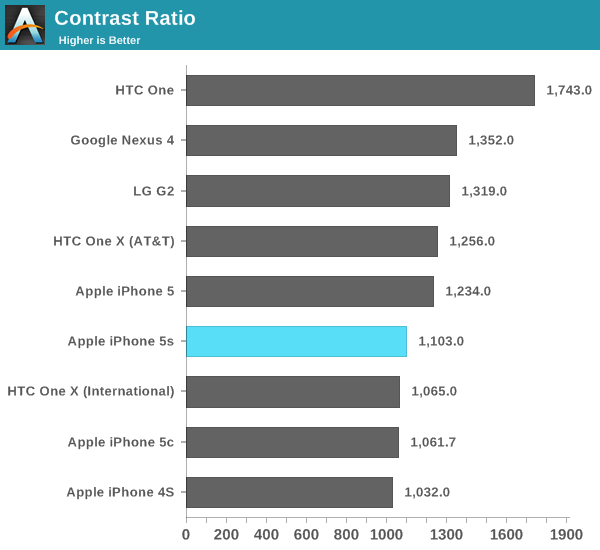
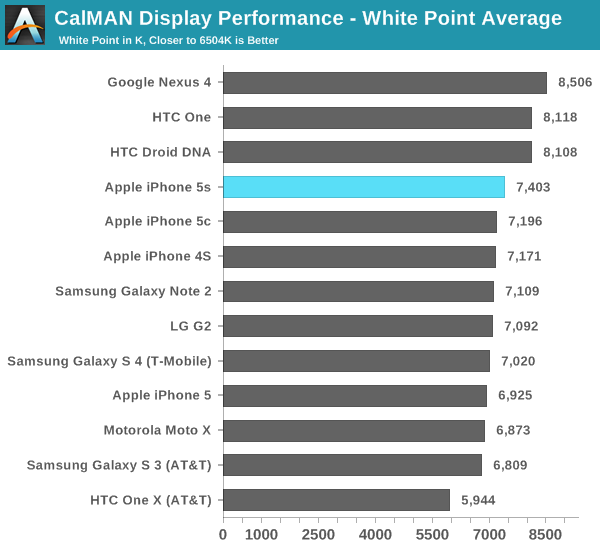

Color accuracy is still excellent just out of the box. Only my iPhone 5c sample did better than the 5s in our color accuracy tests. Grayscale accuracy wasn't as good on my 5s sample however.
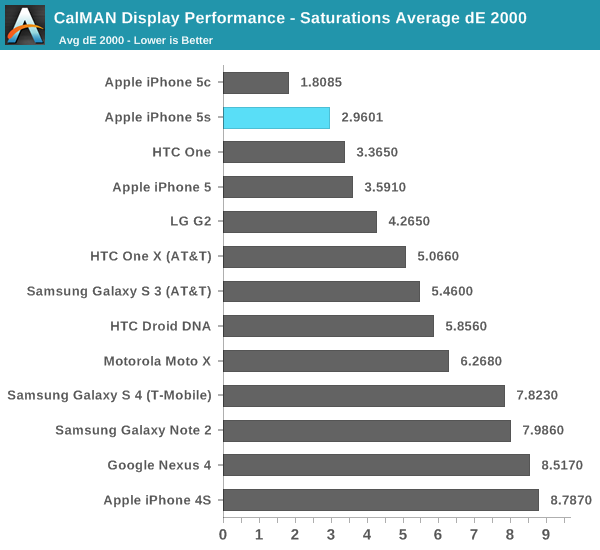
Saturations:

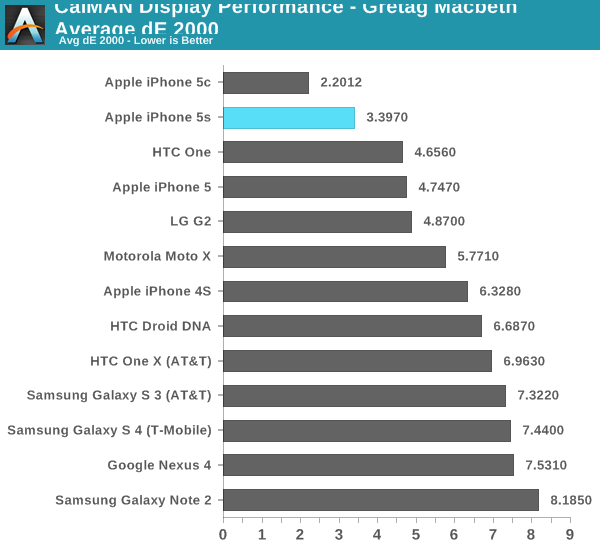
GMB Color Checker:

Cellular
When early PCB shots of the 5s leaked, I remember Brian counting solder pads on the board to figure out if Apple moved to a new Qualcomm baseband solution. Unfortunately his count came out as being the same as the existing MDM9x15 based designs, which ended up what launched. It’s unclear whether or not MDM9x25 was ready in time in order to be integrated into the iPhone 5s design, or if there was some other reason that Apple chose against implementing it here. Regardless of the why, the result is effectively the same cellular capabilities as the iPhone 5.
Apple tells us that the wireless stack in the 5c and 5s is all new, but the lack of LTE-Advanced features like carrier aggregation and Category 4 150Mbps downlink make it likely that we’re looking at a MDM9x15 derivative at best. LTE-A support isn’t an issue at launch, however as Brian mentioned on our mobile show it’s going to quickly become a much needed feature for making efficient use of spectrum and delivering data in the most power efficient way.
The first part is relatively easy to understand. Carrier aggregation gives mobile network operators the ability of combining spectrum across non-contiguous frequency bands to service an area. The resulting increase in spectrum can be used to improve performance and/or support more customers on LTE in areas with limited present day LTE spectrum.
The second part, improving power efficiency, has to do with the same principles of race to sleep that we’ve talked about for years. The faster your network connection, the quicker your modem can transact data and fall back into a lower power sleep state.
The 5s’ omission of LTE-A likely doesn’t have immediate implications, but those who hold onto their devices for a long time will have to deal with the fact that they’re buying at the tail end of a transition to a new group of technologies.
In practice I didn’t notice substantial speed differences between the iPhone 5s, 5c and the original iPhone 5. My testing period was a bit too brief to adequately characterize the device but I didn’t have any complaints. The 5s retains the same antenna configuration as the iPhone 5, complete with receive diversity. As Brian discovered after the launch, the Verizon iPhone 5s doesn’t introduce another transmit chain - so simultaneous voice and LTE still aren’t possible on that device.
Apple is proud of its support for up to 13 LTE bands on some SKUs. Despite the increase in support for LTE bands there are a lot of iPhone 5s SKUs that will be shipped worldwide:
| Apple iPhone 5S and 5C Banding | |||||||
| iPhone Model | GSM / EDGE Bands | WCDMA Bands | FDD-LTE Bands | TDD-LTE Bands | CDMA 1x / EVDO Rev A/B Bands | ||
|
5S- A1533 (GSM) |
850, 900, 1800, 1900 MHz | 850, 900, 1700/2100, 1900, 2100 MHz | 1, 2, 3, 4, 5, 8, 13, 17, 19, 20, 25 | N/A | N/A | ||
|
5S- A1533 (CDMA) |
800, 1700/2100, 1900, 2100 MHz | ||||||
|
5S- A1453 |
1, 2, 3, 4, 5, 8, 13, 17, 18, 19, 20, 25, 26 | ||||||
|
5S- A1457 5C- A1507 |
850, 900, 1900, 2100 MHz | 1, 2, 3, 5, 7, 8, 20 | N/A | ||||
|
5S- A1530 5C- A1529 |
1, 2, 3, 5, 7, 8, 20 | 38, 39, 40 | |||||
| Apple iPhone 5S/5C FCC IDs and Models | |||
| FCC ID | Model | ||
| BCG-E2642A | A1453 (5S) A1533 (5S) | ||
| BCG-E2644A | A1456 (5C) A1532 (5C) | ||
| BCG-E2643A | A1530 (5S) | ||
| BCG-E2643B | A1457 (5S) | ||
| BCG-E2694A | A1529 (5C) | ||
| BCG-E2694B | A1507 (5C) | ||
WiFi
WiFi connectivity also remains unchanged on the iPhone 5s. Dual band (2.4/5GHz) 802.11n (up to 150Mbps) is the best you’ll get out of the 5s. We expected Apple to move to 802.11ac like some of the other flagship devices we’ve seen in the Android camp, but it looks like you’ll have to wait another year for that.
I don’t believe you’re missing out on a lack of 802.11ac support today, but over the life of the iPhone 5s I do expect greater deployment of 802.11ac networks (which can bring either performance or power benefits to a mobile platform).
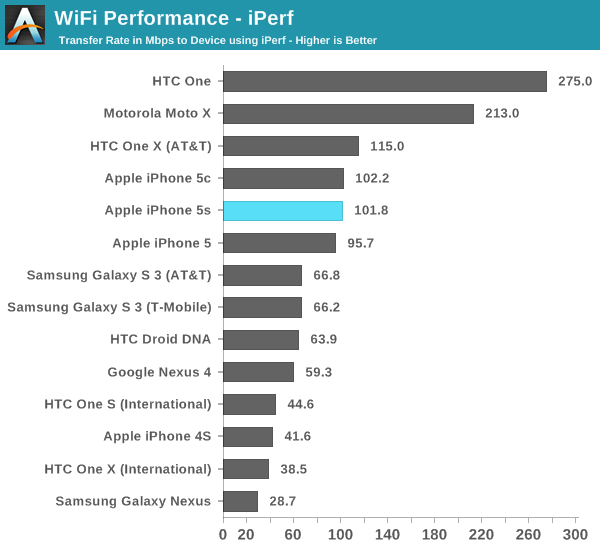
WiFi performance seems pretty comparable to the iPhone 5. The HTC One and Moto X pull ahead here as they both have 802.11ac support.













464 Comments
View All Comments
BrooksT - Wednesday, September 18, 2013 - link
Nobody will disagree because you've completely destroyed your credibility by insulting the credibility, integrity, and competence of the reviewer, the site, and Apple because the evidence doesn't conform to your speculations and bias. You are not to be taken seriously, and at this point I think everyone sees that.Post evidence of this conspiracy or STFU.
ddriver - Thursday, September 19, 2013 - link
How a whiff of reality for you - my credibility is and has not been on the line on this one. You don't know who I am, you don't know my credentials. This is not the case for Anand, even if I am right he is not in the position to admit to compiling the review in a manner that creates an unrealistically good presentation of a product, because unlike for me, that would be a huge credibility calamity for him. If anything, his responses are very "political" carefully dancing around the pivot points of my concerns. While his response did partially bring light to a few of my concerns, my key points remain valid - the article continues to not compare A7 with ARMv7 head to head in the sole native CPU benchmark present in the article, "CPU performance" was not renamed to JS performance or moved to browser performance or something like that. See, just because he didn't agree with my points and admit to being biased does not mean I am wrong and that is not the case, considering he is not in the position to do that. I didn't really expect anything more or less than the same "carefully dancing" answer as the article itself, my main motivation was to show him that not all AT readers are incapable of reading between the lines, for the sake of future articles, I did not expect that he would make any revision to the article at hand. Honesty is for those who have nothing to lose, and while his credibility is no the line, my isn't, make the conclusions, if you can ;)CyberAngel - Thursday, September 19, 2013 - link
Don't worry! I believe you...conditionally!I put it this way: I greatly doubt that the tests would reveal any points that are less than favorable the Apple. ANY company would do the same: promote the best parts and highlight the strength of the product.
akdj - Thursday, September 19, 2013 - link
"You don't know who I am, you don't know my credentials."I'm not sure anyone here is interested---you've already made clear you're a conspiracy theorist, that you believe Apple is paying off reviewers, that you disrespect folks MUCH more intelligent than yourself when it comes to chip architecture...and that your "main motivation was (Is) to show him that not all AT readers are incapable of reading between the lines". You've shown NO one ANYthing substantiated. You continue to argue baseless facts and accuse respected individuals and groups/teams of intelligent members of being bias towards Apple. Nothing in this review supports your claims---NOTHING! And, as I pointed out earlier---even the biggest anti-apple sites are applauding Apple's efforts with this SoC effort.
You're in the minority---and to be so vain that we would care about who you are and what your credentials are is silly. It sounds to me like you're a 17 year old with a decent vocabulary and not enough paper in the pocket to pick up an iPhone 5s for yourself. But...what do I know. I don't know you, your credentials...or how you lean politically, nor do I care.
IMO---you're an insult to the entire Anand crew. I'm not sure why I continue to read your responses, they're all the same, just worded differently. Again...you're in the (extreme) minority. You're certainly not an engineer, chip designer, app developer or technological guru---if you were, you would understand the feat Apple has achieved with this SoC architecture.
J
Nurenthapa - Friday, September 20, 2013 - link
I've been enjoying reading this in China, but you, sir, are really annoying me with your sniveling drivel. You have an axe to grind and simply won't shut up. Hope you disappear from this forum. BTW, I use a HTC One and iPad 2, and occasionally my old original 2007 iPhone. I love IOS and iPhones, but won't be buying one until they come out with a somewhat bigger screen.oryades - Wednesday, September 18, 2013 - link
Intel, now Apple, the same featured reviews.edward kuebler - Wednesday, September 18, 2013 - link
We are talking about 64 bits too much. The story is new instruction set in ARMv8. Instead complicating the hardware for backwards compatibility (e.g. look at x86 still supporting 16bit code) they wrote a new instruction set faster and less energy demanding. There is still ARMv7 compatibility, but the 64bit mode is independent. And the thing is, once you redesign your architecture, why not go 64bit? what´s the point of staying 32 bit? Moving more data is both slower and faster. More and wider registers help compiler optimizations and media decoding. I didn't get all this “cunning deceitful conspiracy” feeling you talk about. Staying in 32 bit land, *that* would keep me guessing.Anand Lal Shimpi - Wednesday, September 18, 2013 - link
Our browser based suite (stressing js/HTML5 and other browser based workloads) remains unchanged from all of the other mobile SoC reviews we've done. There's no way of getting around the software differences on these mobile devices as you buy hardware+software together. Unfortunately it's still our best option for non-GPU cross platform comparisons, there just aren't many good cross platform CPU tests.I called out the inclusion of hardware accelerated AES/SHA when referencing those tests, there were no attempts to hide that fact. The fact remains that those algorithms will see a speedup on ARMv8 hardware because of those instructions. Note this is no different than when we run the TrueCrypt benchmarks on AES-NI enabled processors vs. those that don't have it (e.g. http://images.anandtech.com/graphs/graph5626/44765...
Apple provided absolutely zero guidelines on how the review was to be conducted. The only stipulations were around making sure we didn't disclose the fact that we had devices. In fact, most manufacturers don't - at least not with us. Whenever there are any stipulations presented, we always disclose them on the site (e.g. see our early look at Trinity desktop performance).
Krait implements ARMv7, so that's 64-bit wide registers for its NEON units. It expanded the width of the execution units, but the registers themselves have to adhere to the ARMv7 ISA.
I think we explained why 64-bit makes sense (doing so at the last minute doesn't make sense, immediate SIMD/Crypto perf increases today, and helps build up the ecosystem), and even highlighted cases where a performance degradation does happen (see: Dijkstra tests). Keep in mind that iOS has always erred on the side of being more thrifty with RAM to begin with. I would like to see more but I don't know how necessary it is today.
Take care,
Anand
ddriver - Wednesday, September 18, 2013 - link
Anand, maybe you should hire a developer to write native cross platform benchmark tools. This is the only way to avoid all caveats like sponsored exclusive optimizations, different implementations, eliminate unrealistic low footprint synthetics, "selective compilers" (*cough Intel*) and whatnot. Considering the amount of reviews you are doing and the fact that C/C++ compilers have caught up with ARM for a long time, this is nothing hard and something that entirely makes sense, especially relative to using different JS engine implementations to measure CPU performance. JS should go in the "browser" department, not CPU performance.According to wikipedia, Krait implements 128bit SIMD, so maybe that is a mistake on wikipedia's behalf?
I still think encryption results belong in their own chart, and have no place in a chart that is supposed to be indicative of the integer performance delta between 32 and 64bit execution modes. Even with the clarification you made, it creates an unrealistic impression, not to mention some people skimp over the text and only look at the numbers. Encryption is encryption, integer performance is integer performance. Why mix the two (except for the reason I already mentioned and you deny)?
I wish you'd reflected a bit on the marketing aspect of the transition to 64, considering how much apple is riding it this time around. No one argues 64bit is good and more performance is good, but this brings up the issue of the particular implementation, e.g. a fast chip with only a single gigabyte of ram, and how will that play out with an actual performance demanding real world application.
Thanks for addressing my concerns.
Wilco1 - Wednesday, September 18, 2013 - link
ARMv7 has 32 64-bit SIMD registers but they can also be used as 16 128-bit SIMD registers. Modern CPUs like Cortex-A15 and Krait support many 128-bit SIMD operations in a single cycle, but not all operations are supported (such as double precision FP). ARMv8 has 32 128-bit SIMD registers and supports SIMD of 2 64-bit doubles.